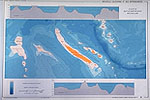 |
QUICK SEARCH
MO PROJECTS:
Africa
Asia/Pacific
Mesoamerica
North America
South America
General Taxonomy
Photo Essays
Training in Latin
America
MO RESEARCH:
Wm. L. Brown Center
Bryology
GIS
Graduate Studies
Research Experiences
for Undergraduates
Imaging Lab
Library
MBG Press
Publications
Climate Change
Catalog Fossil Plants
MO DATABASES:
W³MOST
Image Index
Rare Books
Angiosperm
Phylogeny
Res Botanica
All Databases
INFORMATION:
What's New?
People at MO
Visitor's Guide
Herbarium
Jobs & Fellowships
Symposium
Research Links
Site Map
Search
Diversity, Endemism, and Extinction in the Flora and Vegetation of New CaledoniaGeographic Setting
The Territory of New Caledonia can be divided into the following geographically distinct entities: Essentially all of New Caledonia's botanical diversity is concentrated on Grande Terre. The smaller islands have depauperate, relatively species-poor floras; even the Loyalty Islands have less than 400 species (Jaffré, 1993), representing only a minor sub-set of the diversity occurring on the main island, having been established relatively recently through long-distance dispersal from Grande Terre, and to a much lesser degree from other areas such as Vanuatu (formerly the New Hebrides). Only a few locally endemic species occur on the smaller islands, such as the palmCyphophoenix nucele, which is restricted to a single population on Lifou (cf. MacKee et al., 1985; Jaffré and Veillon, 1989), and no unique vegetation types occur in these areas. Because the younger surrounding islands are of limited interest botanically, only Grande Terre will be taken into consideration below.
|
© 1995-2025 Missouri Botanical Garden, All Rights Reserved
4344 Shaw Blvd.
St. Louis, MO 63110
(314) 577-5100
Technical Support
